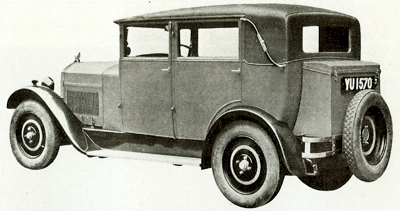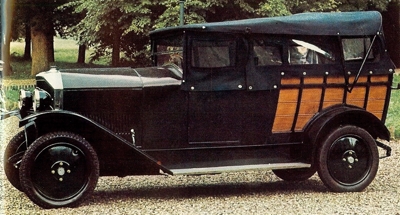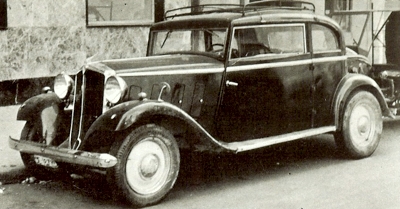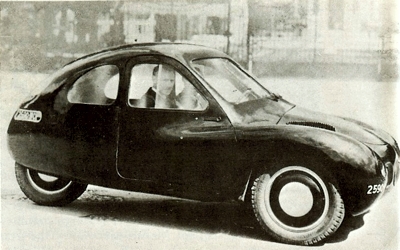OF THE MANY MAKES of cars which have ceased production down the years - and they numbered hundreds in the prolific, optimistic, nineteen-twenties - inevitably there were some which were confusing, even in their hey-day, by reason of the complexity of the range of models and body-styles offered, and some which were useful, well-made machines but which at the time seemed comparatively dull to experienced keen drivers. Fortunately, such makes,.undistinguished as they may have been at the time, are interesting historically.
Emile Mathis
Such a car was the Mathis. Emile Mathis, who was born in Strasbourg in 1880, built sober cars, but this he offset by entering some improbable ones in races. It seems that he found out about motor-engineering by serving an apprenticeship in London. By 1898, at a time when wealthy adventurers were investigating the pleasures and perils of travelling, if not very far (without resort to horses), Mathis returned to Alsace to set up in the motor trade.
The Prince Henry Trials
He soon built up a large and successful business, selling many famous makes of early automobile and eventually establishing a Fiat and a Minerva agency for much of Austria and Germany. His practical participation in the sport seems to have begun in 1901 and thereafter he appeared in competitions such as the touring class of the race from Paris to Berlin and the renowned Prince Henry Trials at the wheel of de Dietrich and Fiat cars.
Mathis rose to a considerable height in German automobile trade circles and before war had broken out he had decided to make cars of his own, while continuing his successful sales business. He dabbled with the early designs of the celebrated Ettore Bugatti with whom he presumably came in contact through acquiring the de Dietrich import-rights from France after the Germans had closed the Niederbronn branch of this company - Bugatti also-having a working arrangement with de Dietrich.
A few Hermes-Bugattis may have been produced before Ettore severed connections in 1906, but it was not until about 1910 that Emile Mathis had a manufacturing facility. Even with Mathis established in a factory of his own, at Stettin, the position was confusing, because he was using the well-established 1½-liter and 2-liter Stoewers and putting on different radiators and hub-caps prior to selling them as Mathis, although in London, according to Lord Montagu, they were apparently called Mathis. Moreover, the wily Mathis appears to have charged more for such Stettin Mathis models than he did for the virgin Stoewers.
The Mathis Babylette
Going on with his competition activities, Mathis had no compunction about entering Stoewers as cars of his own make, even when an identical Stoewer was running. But all this was a ploy only while his factory at Strasbourg was being completed. By 1913 he was ready to produce his first true Mathis car in considerable numbers, speaking of 200 chassis a year to England alone when touting for an agent. This car was the Mathis Babylette. It followed the pattern of economy-car design that was then emerging, namely a breakaway from the 'stick-and-string' cyclecar towards a big car in miniature, even if Mathis skimped somewhat when proceeding along those lines.
 1.8 Litre 6-cylinder Mathis Emysix, which featured coil ignition, hypoid final drive and twin detachable heads for its monobloc engine.
1.8 Litre 6-cylinder Mathis Emysix, which featured coil ignition, hypoid final drive and twin detachable heads for its monobloc engine.
 1922 Mathis, featuring a wooden body.
1922 Mathis, featuring a wooden body.
 1934 Mathis Emyquarte.
1934 Mathis Emyquarte.
 1946 3 wheel Mathis 333. In a car-starved post war Europe, it was exactly what the public wanted. However, the government would not allow the car to be put into production.
1946 3 wheel Mathis 333. In a car-starved post war Europe, it was exactly what the public wanted. However, the government would not allow the car to be put into production. |
The engine was a straight-forward L-head (side-valve) four-cylinder of 951 cc, with a bore and stroke of 58 x 90 mm, which would run up to 1800 rpm and which pulled a top gear of 4.5 to 1. From this dreary if useful design stemmed most of the subsequent Mathis models for the next thirteen years. Before war engulfed Europe and the Strasbourg factory, Mathis had taken the customary step of increasing slightly the size of the Babylette's power unit to gain some small increase in performance, even though a top speed of 45 mph was claimed for the original model, which was excellent going for a one-liter small car in Edwardian days.
The 1914 version had the identical cylinder bore but the stroke had been lengthened to 100 mm, giving a swept-volume of 1056 cc. The next move was to enlarge the bore, to 60 mm, so that some 14 bhp was developed. These little pre-war Mathis cars had three-bearing crankshafts, thermo-syphon cooling, and a simple, but apparently effective, lubrication system consisting of flywheel-feed to a series of troughs and ducts for splash oiling of the bearings. Perhaps it was Emile's past competition driving that prompted him to put a sports edition of the Babylette in his catalogue. This was an amusing little thing, which dispensed with the differential used for the touring models but which was given to pump cooling, and wire wheels.
The Mathis Popular
These Babylettes were supported by a 1327 cc Baby with four-speed gearbox and among these pre-1915 Mathis offerings there was a less expensive three-speed 1500 cc Popular, as well as' larger cars that had a ring of the old Stoewer line about them. The latter embraced the 2.6-liter and the 3.4-liter four-cylinder types, as well as an 18-24. In Europe, but not in Britain, Mathis listed a Knight sleeve-valve-engined model. But the car sold by the famous London store. of Harrod's, which claimed to be able to supply everything that a customer could require, as a Harrod was in reality a Mathis Babylette on which had been performed the old trick of fitting a special radiator.
Until the outbreak of war, Emile enjoyed entering quite improbable Mathis cars for various races, some of them quite important ones, naturally without success but in a manner that brought his cars to the public's notice. He seemed to be doing very nicely by 1913, when at the celebrated Paris Salon glass bonnets were used to reveal the ordinariness of the engines beneath and a deal, which never went through, was being attempted with the Gnome aero-engine concern to build car engines for Mathis, this being a throw-back to his agency for the Gnome rotary engine in Germany.
Moving from Strasbourg Germany to France
Then the Kaiser upset these and many other promising plans and Mathis got out of Strasbourg and went, via Switzerland, to France. Strasbourg was over-run and as in the case of Bugatti, it gave the Mathis French nationality after the Armistice. In this newly-French territory Emile proposed to extend his ruined works and go in for mass-production on a scale Citroen and Renault were soon to embrace in fact. As has been said, the pre-war design was made use of, known in 1919 as the Mathis PB and PRC models. The SB followed, being a post-war product, of 1131 cc, notable for a four-speed gearbox but otherwise following Mathis practice, with a central accelerator pedal, rear brakes, central gear lever working in a ball gate and a differential in its back axle.
This was both an economical and a fast car and its price of £490 on the British market was not excessive at this difficult period in post-war reconstitution, although the true mass-producers were soon able to drop prices dramatically. For a time, though, this small Mathis was as good as any other car, on paper anyway. Mathis, with his sights on a stupendous factory which would churn out cars at a prodigious rate, nevertheless was not averse to allowing others to use his components in assembled form, suitably disguised by name and/or a different radiator, such variants being known in England, Holland and Sweden shortly after the end of the war.
The 1921 French Grand Prix
Nor had Emile been cured of his propensity for entering motor races with unsuitable motor cars. This came to a climax in the 1921 French Grand Prix, run at Le Mans, where, against the might of the 3-liter European cars and the victorious American Duesenberg, he ran a tiny 1½-liter Mathis. Admittedly it had an overhead camshaft engine, dual ignition and four-wheel-brakes. It failed dismally, however it may have been because of this racing car that the overhead valve development of the SB model emerged in 1921, recognisable by its smart and quite large vee-radiator.
But any sporting leanings the founder of the company may have had were to be balanced by the advent of the fuel-thrifty Citroen 5CV at the motor shows. Mathis had to reply to this challenge and he did so with an even smaller-engined car, his 6CV. The power designation is misleading, because whereas the 5CV Citroen had an 850 cc water-cooled, four-cylinder, engine, the little Mathis, which was the answer to it, was of 55 x 80 mm, which gave it an engine capacity of only 760 cc, or one not much bigger than the tiny power unit of the ever popular
Austin Seven.
It was not a bad attempt to woo the more mobile French peasants from their lemon-hued Citroens. There was electric lighting but no instruments, a frugality of brake drums by having the pedal actuate one and a lever another on the solid back axle, and simplicity in the lightweight engine by using an integral block and head. The smallest of the Mathis family retained the four-speed gearbox often favored for earlier models and its three-bearing crankshaft was likewise appreciated, even if it encouraged revs that were liable to lead to mechanical disaster.
This P-type persisted until 1925 but even then was still somewhat more expensive than the Citroen it was intended to depose. The next gambit of Emile Mathis was to become enthusiastic over the very small-size six-cylinder engine. Others went for this trend, even Daimler and Talbot, following a lead much earlier by AC, and the Wolseley Hornet will forever be remembered in this context. Mathis had been trying-out small six-cylinder power units from about 1920. In 1923 came the 1140 cc side-valve six from Strasbourg. It was a staid vehicle, more or less a type-P with two extra 'pots'.
More interesting was the overhead-valve L-type six. It was a very racy-looking motor-car, with a long bonnet, flared wings above its balloon-tyred disc wheels, and a short stroke engine of 60 x 70 mm, which, in conjunction with a higher back axle ratio than it had been usual for Mathis to provide, gave a top speed of some 70 mph. The great Welsh racing driver Parry Thomas was photographed peering under the bonnet of one of these rakish cars when Motor Sport took it to Brooklands for a test, but it was curiosity only and nothing more came of it, although Thomas did have a sports Amilcar at the time.
The Mathis Type-MY
In touring-car events of those 1920s Mathis gained some useful successes, and even went to a crab-track chassis and aerodynamic bodywork for some of these races. But from 1924 to 1926 the catalogue cars were a varied bunch. There were more small fours, the sixes, and a straight-eight of under 2-Iitres which is best forgotten. To combat Citroen sales, a 1.6-liter, four-cylinder saloon known as the type GM arrived in 1925, with pressure lubrication. It cost £295 in England. But for 1927 it was thought best to pursue a one-model policy, with a very dull 1.2-Iitre, four-cylinder, two-bearing car, the type-MY. It remained faithful to the four-speed gearbox but had only 6-volt electrics.
The Mathis Emysix
It was followed by another six-cylinder model, the better-known Emysix, which was quite a light car for its size and was the design on which Mathis production models were based for a long time ahead. By the middle of the vintage period, Mathis was fourth in the French output stakes, behind Citroen, Renault and Peugeot. However, where Citroen had some interesting ideas, the Renault was ever-lasting, and the Peugeot was even pretty in some forms, the Mathis was just a sensible slogger. As time moved on bigger models were featured in the Mathis catalogue, but still there was nothing very exciting.
The Mathis 1.2-liter PY
In 1931 there was a 1.2-liter PY with the engine dimensions of 70 x 80 mm and then by 1932 it was back to a wide range of cars, from a 904 cc four-cylinder to a couple of straight-eights, the bigger eight the type-FOH of j-Iitres capacity. The mid-thirties saw the inevitable introduction of independent front suspension, by a transverse leaf springs on the sixes, and the use of the free-wheel, in which Mathis was by no means alone at this time. The sales picture was becoming depressing, however, and an attempt was made to get Henry Ford interested in Mathis production.
Matfords
That Emile had been well to the fore with innovations such as hydraulic brakes and synchromesh gearboxes has to be said, and this may have put him in a good position to talk with Ford. Alas, the result was not what he had hoped, for the Mathis production lines were soon engaged in making French editions of the Ford V8, called Matfords. This went on until 1961, Simca taking over where Ford left off. After the war the factory was again in Mathis' control. But he had lost his ability to manufacture cars that even the war-starved public wanted.
A three-wheeled coupe with a 700 cc flat-twin engine was a failure and so was an ambitious front-wheel-drive 2.8-liter flat-six that came after it, in 1948. Five years later Citroen, the rival that Emile Mathis had sought to compete against, took over his plant. Thus a very long innings was over, for a French make which never quite made the grade but which was nevertheless very much a background to the complex and prolific French motor-manufacturing scene.
